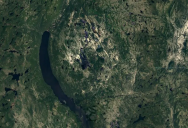New Potential Meteor Impact Site Discovered By Regular Guy On Google Maps While Planning A Trip

Google Maps is a great tool that you can use to look up directions, learn geography, and much more. Every once in a while, it’s also a way to make unexpected discoveries.
That’s what happened to Joel Lapointe when he was using Google Maps to plan out a camping trip to Quebec, Canada.
While looking at different areas, he noticed something weird on the map. An area that was roughly spherical and about 15 kilometers (9.3 miles) across right near Marsal Lake.
He thought this was unusual enough that he reached out to geophysicist Pierre Rochette at the Center de Recherche en Geosciences de L’environment (CEREGE), which is based in France.
After looking at the images in maps and doing some research, it looks like this odd area was likely caused by a meteor impact in the distant past. This impact was not yet known, so it was very exciting for the people who do this type of research.
Rochette even talked about it with the CBC news outlet, saying:
“Looking at the topography, it’s very suggestive of impact.”
He and a team went on to perform additional research into this area. In their paper, they wrote:
“This formation, interpreted as a volcanoclastic diatreme formation named Marsal breccia, in an area devoid of post Grenvillian magmatism […] is in fact more in agreement with a crater floor clast-poor melt rock, quite similar to the Mistastin and Janisjarvi cases.”

The area was previously believed to have been created by volcanic activity, but it doesn’t look like that anymore
Additional research will need to be done, but this is just one more example of how average people can discover things using everyday tools like Google Maps or Google Earth.
In the paper, the team went on to add:
“Based on the already available preliminary evidence, Lake Marsal seems to be a serious candidate to become the 11th confirmed impact structure from Quebec. Confirmation of impact origin may be gained from the available sampling or else may wait for a future dedicated expedition.”

Next time you are planning a trip, keep an eye out for anomalies on Google Maps.
If you thought that was interesting, you might like to read about 50 amazing finds on Google Earth.

Sign up to get our BEST stories of the week straight to your inbox.




